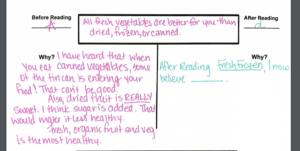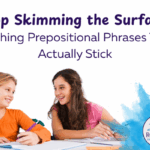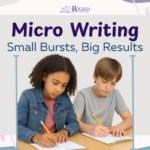While activating background knowledge might not be one of the “Super 6” comprehension strategies, I would argue that this is where every reader should start. As a reader, when I pick up a new text, I question what it is going to be about and what I already know about the subject. Sometimes, I might research something before I even begin reading. Many of our students need to be taught how to make this an independent process, and they will need a teacher to help activate their schema and teach them explicitly (how, when, and why) to do this on their own in the future.
How?
One of my favorite ways to activate schema in the classroom is to design an Anticipation Reaction Guide on the content of the new text. I have seen these guides used in various ways, but I really feel it is best to only ask opinion questions. In other words, I never ask questions that will make the students either correct or incorrect. I value the process of students thinking, compiling evidence, and discussing their thinking, rather than catching students in a right/wrong situation that might make them less receptive to answering questions or voicing their thoughts in the future. Here’s how we use Anticipation Reaction Guides:
- Write an opinion question. As the teacher, take the content of the text you are about to read and formulate an opinion question. An example might be if you are about to read an article about Halloween candy being given out, you might ask ‘Should all candy that is handed out should be wrapped with nutrition information on the package?’
- Students answer the question. Provide time for the students to decide if they strongly agree, somewhat agree, strongly disagree, or somewhat disagree. They must also formulate why they feel the way that they do.
- Students discuss their thinking. Have students in pairs, small groups, or whole class, discuss their
 initial thinking. Inevitably, I have a few who want to change their opinions after they talk. I am okay with it, but you can decide for your class. Sometimes I mark the four corners of the room with the four possible responses and have the students actually move to the appropriate corner to indicate their opinion and discuss first with like-minded thinkers. Then we debate it out as a whole class. This, of course, depends on the class and how much coffee I have had.
initial thinking. Inevitably, I have a few who want to change their opinions after they talk. I am okay with it, but you can decide for your class. Sometimes I mark the four corners of the room with the four possible responses and have the students actually move to the appropriate corner to indicate their opinion and discuss first with like-minded thinkers. Then we debate it out as a whole class. This, of course, depends on the class and how much coffee I have had. - Students read the text. This activity has activated the students’ schema for what they are about to read, and in many cases, it gets them excited and ready to read to find more evidence to argue for their point. Kids will be kids, right? So now, the purpose of reading is to find text evidence to support their opinions or to see if their opinion changes once they have more information.
- Students answer the question, again. Now that the students have read and highlighted key points, they answer the same question again. They should know it’s okay to think more strongly now, the same, or different from the beginning. There is no right or wrong. This time when they answer how they feel, they must write text-evidence for their answer.
- Students share new thinking. Allow time for more discussion and sharing of evidence that solidified their thinking or helped guide them in thinking differently.
I have found that not only does following this process activate schema, it also engages my students in reading and makes them eager to read more closely.
Here is a PDF of my template: Anticipation Reaction Guide (1)
How do you use Anticipation Reaction Guides?




